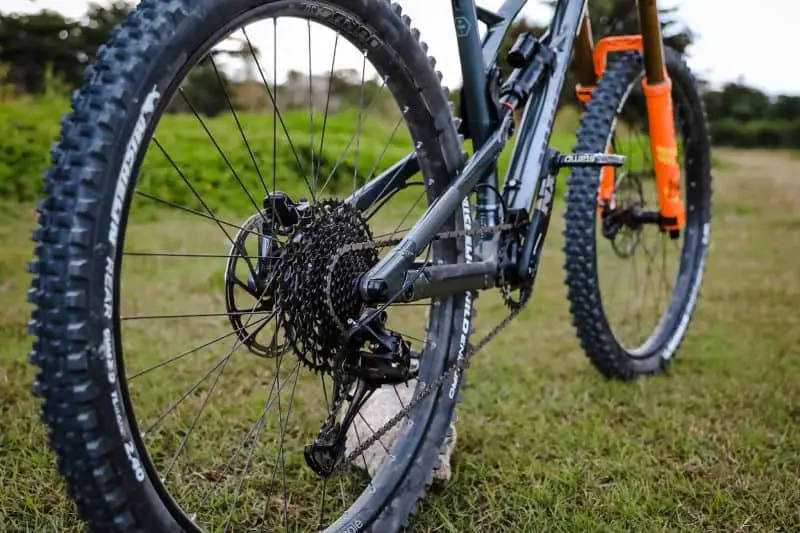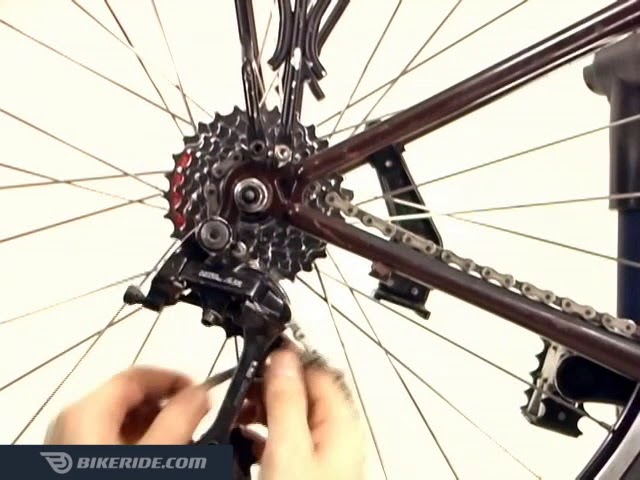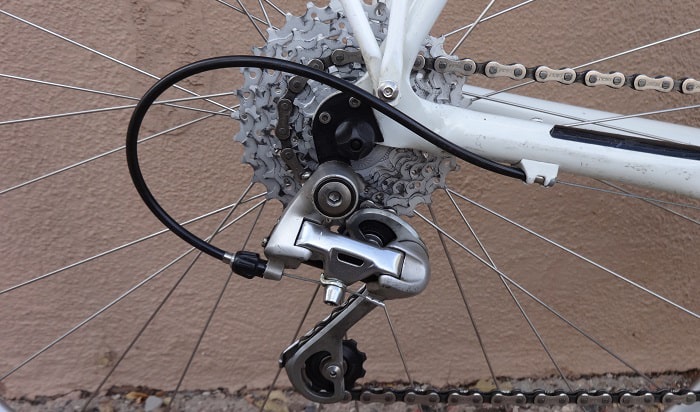Understanding the Importance of a Reliable Rear Derailleur
A mountain bike’s gear system is only as strong as its weakest link, and a reliable rear derailleur is crucial for smooth shifting, chain stability, and overall ride quality. The rear derailleur plays a vital role in navigating challenging terrain, from steep inclines to technical descents, by providing precise gear changes and minimizing chain slap. A well-functioning rear derailleur ensures that the chain remains on the correct gear, reducing the risk of dropped chains, bent derailleurs, and costly repairs.
In addition to its mechanical benefits, a reliable rear derailleur also enhances the overall riding experience. By providing seamless gear transitions, riders can focus on the trail ahead, rather than worrying about gear malfunctions. This increased confidence inspires riders to push their limits, explore new trails, and enjoy the thrill of mountain biking.
When selecting a mountain bike rear derailleur, it’s essential to consider factors such as compatibility, durability, and adjustability. A derailleur that is compatible with your bike’s gear system and riding style will provide optimal performance, while a durable derailleur will withstand the rigors of frequent use. Adjustability is also crucial, as it allows riders to fine-tune their derailleur for precise shifting and optimal performance.
By understanding the importance of a reliable rear derailleur, mountain bikers can make informed decisions when selecting and maintaining their gear system. A well-maintained rear derailleur is essential for a safe, enjoyable, and performance-driven ride. In the next section, we’ll explore the key considerations for choosing the right rear derailleur for your mountain bike.
How to Choose the Right Rear Derailleur for Your Mountain Bike
Selecting the right mountain bike rear derailleur can be a daunting task, especially with the numerous options available in the market. However, by considering a few key factors, you can find a derailleur that suits your riding style, terrain, and bike type. Compatibility is a crucial aspect to consider, as a derailleur that is not compatible with your bike’s gear system can lead to poor shifting performance and increased wear and tear.
Durability is another essential factor to consider when choosing a mountain bike rear derailleur. A durable derailleur can withstand the rigors of frequent use and harsh weather conditions, reducing the need for frequent repairs and replacements. Look for derailleurs made from high-quality materials, such as aluminum or carbon fiber, and those with a reputation for reliability and longevity.
Adjustability is also a vital consideration when selecting a rear derailleur. A derailleur that is easy to adjust and fine-tune can provide precise shifting and optimal performance. Look for derailleurs with features such as barrel adjusters, limit screws, and B-tension adjustment, which allow for easy adjustment and customization.
Additionally, consider the type of riding you will be doing most often. If you are a cross-country rider, a lightweight and efficient derailleur may be the best choice. If you are a downhill or enduro rider, a more robust and durable derailleur may be necessary. By considering these factors, you can find a mountain bike rear derailleur that meets your specific needs and provides optimal performance.
Some popular mountain bike rear derailleurs that are known for their performance and durability include the Shimano XT and SRAM X01. These derailleurs offer a range of features and benefits, including precise shifting, durability, and adjustability. In the next section, we will take a closer look at these and other popular rear derailleur models, highlighting their features, benefits, and drawbacks.
Top-Rated Mountain Bike Rear Derailleurs: A Review of Popular Options
When it comes to selecting a mountain bike rear derailleur, there are several top-rated options to consider. In this section, we’ll review and compare some of the most popular rear derailleur models, including the Shimano XT and SRAM X01. These derailleurs are known for their high-performance capabilities, durability, and adjustability.
The Shimano XT rear derailleur is a popular choice among mountain bikers, offering precise shifting and durability. This derailleur features a robust design, with a stainless steel pivot bolt and a durable chain guide. The XT also offers a wide range of adjustment options, including barrel adjusters and limit screws, making it easy to fine-tune for optimal performance.
The SRAM X01 rear derailleur is another top-rated option, known for its high-performance capabilities and durability. This derailleur features a unique clutch system, which helps to reduce chain slap and improve shifting accuracy. The X01 also offers a range of adjustment options, including a barrel adjuster and limit screws, making it easy to customize for optimal performance.
Other popular rear derailleur models include the Shimano SLX and SRAM GX. These derailleurs offer a range of features and benefits, including durability, adjustability, and high-performance capabilities. When selecting a rear derailleur, it’s essential to consider factors such as compatibility, durability, and adjustability, as well as your specific riding style and terrain.
In addition to these popular models, there are also several other rear derailleur options available, including those from brands such as Campagnolo and Rotor. When selecting a rear derailleur, it’s essential to research and compare different models, considering factors such as performance, durability, and adjustability.
By selecting a high-performance rear derailleur, mountain bikers can enjoy improved shifting accuracy, increased durability, and enhanced overall ride experience. In the next section, we’ll discuss the benefits of upgrading to a high-performance rear derailleur, including improved shifting accuracy, increased durability, and enhanced overall ride experience.
The Benefits of Upgrading to a High-Performance Rear Derailleur
Upgrading to a high-performance rear derailleur can have a significant impact on the overall performance and ride quality of your mountain bike. A high-performance rear derailleur can provide improved shifting accuracy, increased durability, and enhanced overall ride experience. In this section, we’ll discuss the benefits of upgrading to a high-performance rear derailleur and how it can improve your mountain biking experience.
One of the primary benefits of upgrading to a high-performance rear derailleur is improved shifting accuracy. A high-performance rear derailleur is designed to provide precise and smooth shifting, even in the most demanding conditions. This means that you can enjoy seamless gear changes and reduced chain slap, allowing you to focus on the trail ahead.
In addition to improved shifting accuracy, a high-performance rear derailleur can also provide increased durability. High-performance rear derailleurs are designed to withstand the rigors of frequent use and harsh weather conditions, reducing the need for frequent repairs and replacements. This means that you can enjoy a longer lifespan from your rear derailleur and reduced maintenance costs.
Another benefit of upgrading to a high-performance rear derailleur is enhanced overall ride experience. A high-performance rear derailleur can provide a more responsive and engaging ride, allowing you to enjoy the thrill of mountain biking to the fullest. With improved shifting accuracy and increased durability, you can focus on the trail ahead and enjoy the ride, rather than worrying about gear malfunctions or chain slap.
When upgrading to a high-performance rear derailleur, it’s essential to consider factors such as compatibility, durability, and adjustability. Look for a rear derailleur that is compatible with your bike’s gear system and riding style, and one that offers a range of adjustment options to fine-tune for optimal performance.
By upgrading to a high-performance rear derailleur, mountain bikers can enjoy improved shifting accuracy, increased durability, and enhanced overall ride experience. In the next section, we’ll discuss common rear derailleur issues and provide tips and tricks for troubleshooting and resolving these problems.
Troubleshooting Common Rear Derailleur Issues: Tips and Tricks
Despite their importance, rear derailleurs can be prone to issues, such as ghost shifting, chain skipping, and derailleur misalignment. In this section, we’ll provide tips and tricks for troubleshooting and resolving common rear derailleur problems, helping you to get back on the trail quickly and efficiently.
Ghost shifting is a common issue that can occur when the rear derailleur is not properly aligned or adjusted. To resolve this issue, check the derailleur’s alignment and adjust the limit screws as needed. Also, ensure that the cable tension is proper and the derailleur is properly secured to the frame.
Chain skipping is another common issue that can occur when the rear derailleur is not properly adjusted or maintained. To resolve this issue, check the chain for wear and tear, and replace it if necessary. Also, ensure that the derailleur is properly aligned and adjusted, and that the cable tension is proper.
Derailleur misalignment is a common issue that can occur when the rear derailleur is not properly installed or adjusted. To resolve this issue, check the derailleur’s alignment and adjust the limit screws as needed. Also, ensure that the derailleur is properly secured to the frame and that the cable tension is proper.
In addition to these common issues, there are several other problems that can occur with rear derailleurs, such as worn-out or damaged parts, improper installation, and poor maintenance. To prevent these issues, it’s essential to regularly inspect and maintain your rear derailleur, and to address any problems promptly.
By following these tips and tricks, you can troubleshoot and resolve common rear derailleur issues, ensuring that your mountain bike is running smoothly and efficiently. In the next section, we’ll provide a step-by-step guide on how to install and adjust a rear derailleur for optimal performance.
How to Install and Adjust a Rear Derailleur for Optimal Performance
Installing and adjusting a rear derailleur can be a daunting task, but with the right steps and techniques, you can ensure optimal performance and longevity. In this section, we’ll provide a step-by-step guide on how to install and adjust a rear derailleur, including tips on cable tension, limit screw adjustment, and B-tension setup.
Step 1: Install the Rear Derailleur
Begin by installing the rear derailleur on the bike frame. Make sure to follow the manufacturer’s instructions for proper installation. Typically, this involves attaching the derailleur to the frame using a bolt or screw.
Step 2: Adjust the Cable Tension
Next, adjust the cable tension by turning the barrel adjuster. The ideal cable tension will depend on the type of derailleur and the bike’s gear system. Consult the manufacturer’s instructions for specific guidance.
Step 3: Adjust the Limit Screws
Adjust the limit screws to set the derailleur’s range of motion. The limit screws control how far the derailleur can move in either direction. Make sure to adjust the screws carefully, as over-adjustment can lead to poor shifting performance.
Step 4: Set the B-Tension
Set the B-tension by adjusting the B-tension screw. The B-tension screw controls the derailleur’s spring tension, which affects the shifting performance. Consult the manufacturer’s instructions for specific guidance on setting the B-tension.
Step 5: Test the Derailleur
Finally, test the derailleur by shifting through the gears. Make sure the derailleur is shifting smoothly and accurately. If necessary, make adjustments to the cable tension, limit screws, or B-tension to optimize performance.
By following these steps and tips, you can ensure optimal performance and longevity from your rear derailleur. Regular maintenance and adjustment are also crucial to maintaining optimal performance. In the next section, we’ll discuss the importance of regular maintenance and care for your rear derailleur.
Maintenance and Care: Keeping Your Rear Derailleur in Top Condition
Regular maintenance and care are essential to keeping your mountain bike rear derailleur in top condition. A well-maintained rear derailleur will provide smooth shifting, reliable performance, and extended lifespan. In this section, we’ll discuss the importance of regular maintenance and care for your rear derailleur, including cleaning, lubrication, and inspection schedules.
Cleaning the Rear Derailleur
Regular cleaning is essential to remove dirt, grime, and debris that can accumulate on the rear derailleur. Use a soft-bristled brush and mild soap to clean the derailleur, paying attention to the pivot points and cable guides. Avoid using harsh chemicals or abrasive materials that can damage the derailleur’s finish or harm its components.
Lubricating the Rear Derailleur
Lubrication is crucial to keep the rear derailleur’s pivot points and moving parts running smoothly. Use a high-quality lubricant specifically designed for bicycle components, and apply it to the pivot points and cable guides. Avoid over-lubricating, as this can attract dirt and debris.
Inspecting the Rear Derailleur
Regular inspection is essential to identify any potential issues or wear and tear on the rear derailleur. Check the derailleur’s alignment, cable tension, and limit screws, and adjust as necessary. Also, inspect the derailleur’s components, such as the pulleys and cage, for signs of wear or damage.
By following these maintenance and care tips, you can keep your mountain bike rear derailleur in top condition, ensuring smooth shifting, reliable performance, and extended lifespan. In the next section, we’ll summarize the key takeaways from the article and provide final recommendations for finding the ideal rear derailleur for your mountain bike, riding style, and budget.
Conclusion: Finding the Perfect Rear Derailleur for Your Mountain Bike
In conclusion, finding the perfect rear derailleur for your mountain bike requires careful consideration of several factors, including compatibility, durability, and adjustability. By understanding the importance of a reliable rear derailleur and following the tips and recommendations outlined in this article, you can optimize your mountain bike’s gear system and enjoy a smoother, more efficient ride.
When selecting a rear derailleur, consider your riding style, terrain, and bike type, and choose a model that meets your specific needs. Look for a derailleur with a reputation for reliability, durability, and adjustability, and consider upgrading to a high-performance model for improved shifting accuracy and overall ride experience.
Remember to regularly maintain and care for your rear derailleur, including cleaning, lubrication, and inspection schedules, to ensure optimal performance and extended lifespan. By following these tips and recommendations, you can find the perfect rear derailleur for your mountain bike and enjoy a more enjoyable, efficient, and safe ride.
Ultimately, the key to finding the perfect rear derailleur is to do your research, consider your specific needs, and choose a model that meets your requirements. By doing so, you can optimize your mountain bike’s gear system and enjoy a more enjoyable, efficient, and safe ride.









